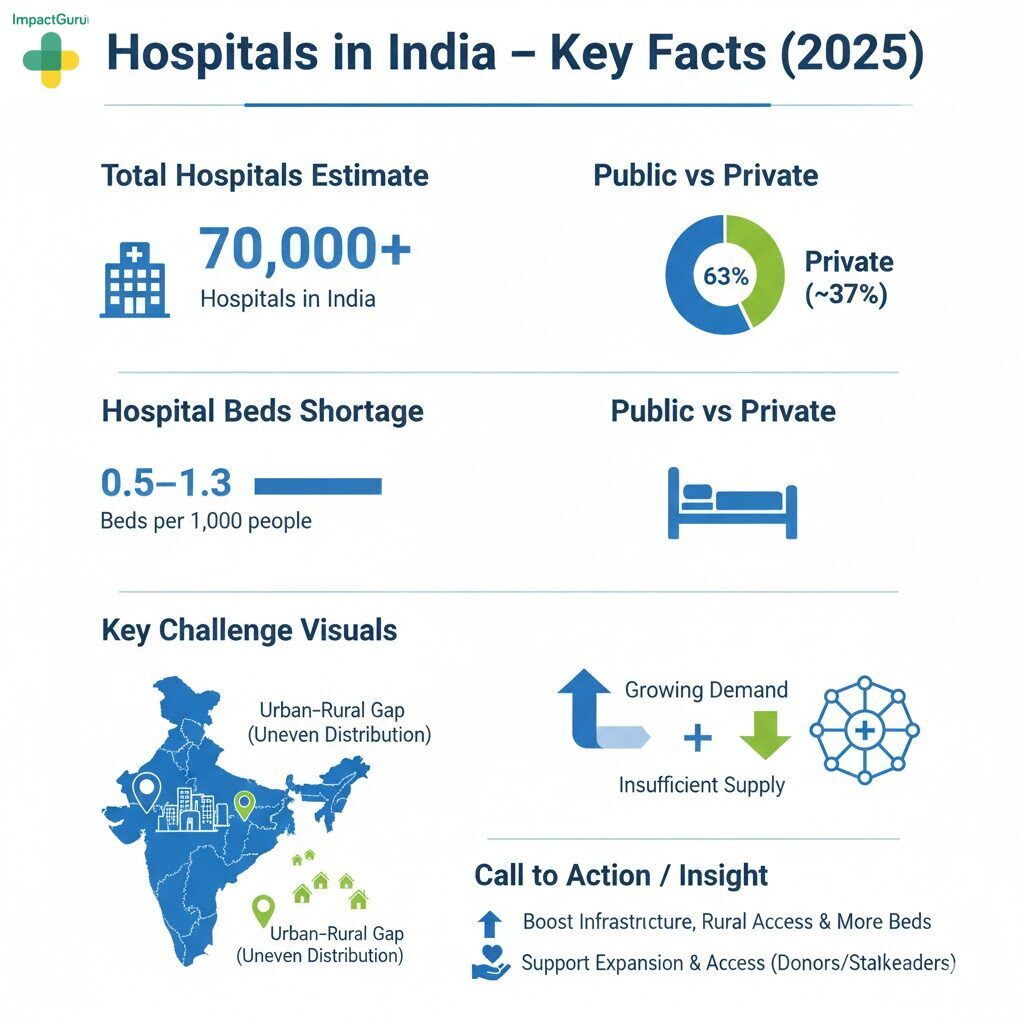India has a growing population of over 1.4 billion, and for such a big population, there is a need for a strong healthcare system. Thankfully, the country has one of the largest and most diverse healthcare systems in the world, with a huge number of hospitals in India. This healthcare system covers everything from government-run institutions in remote rural areas to private hospitals in metros.
India has a rapidly growing healthcare system with thousands of hospitals across the country. Despite the widespread availability, patients sometimes need extra financial support, making crowdfunding in India a helpful option.
In this blog, we will learn about the total number of hospitals in India, how many private hospitals there are in India, and the public vs. private hospital insights.
With thousands of hospitals offering specialized treatments, families can raise money online to cover costs for surgeries, diagnostics, or long-term care in any part of India.
Table of Contents
Total Number of Hospitals in India

As of the latest data from the Ministry of Health and Family Welfare, the total number of hospitals in India is around 70,000. This includes both public and private healthcare institutions. Reliable crowdfunding platforms allow patients to share their medical needs and reach potential donors who can support treatment at hospitals nationwide.

Government Hospitals
As per the Ministry of Health and Family Welfare’s 2018 report, there are:
-
- 23,582 government hospitals
-
- 29,899 Primary Health Centres (PHCs)
-
- 5,568 Community Health Centres (CHCs)
-
- 1,255 Sub-District Hospitals (SDHs)
-
- 1,003 District Hospitals (DHs)
Over the years, this number has increased due to increasing health awareness, population rise, and government initiatives to improve rural healthcare. As of 2025, there are approximately 26,000 government hospitals in India.
The increasing number of hospitals highlights the need for accessible healthcare, and crowdfunding India has emerged as a valuable tool for patients to manage treatment expenses.
Private Hospitals
On the other side, India has a strong private healthcare sector. According to the WHO Global Health Observatory, there are 43,486 private hospitals across the country.
This wide network of hospitals plays an important role in providing access to treatment across both urban and rural regions of the country.
Also Read– Best Nephrology Hospital in Bangalore
Also Read- Impactguru hospital finder
How Many Private Hospitals are in India?
India’s private healthcare sector is among the largest in the world. Currently, there are 43,486 private hospitals in India. These hospitals form a major part of the country’s healthcare system, especially in urban areas.
The private sector contributes significantly to India’s healthcare capacity:
-
- 1.18 million beds
-
- 59,264 ICUs
-
- 29,631 ventilators
In terms of overall healthcare infrastructure, private hospitals account for nearly 62% of all facilities in India.
Out of 35 Indian states and Union Territories (excluding Ladakh), 15 states, including Andhra Pradesh, Maharashtra, Karnataka, Tamil Nadu, and Uttar Pradesh, have more private hospitals, beds, ICUs, and ventilators than public healthcare. These 15 states represent about 74% of India’s population, and in these regions, private infrastructure makes up around 69–70% of the total healthcare setup.
Using a trusted crowdfunding platform in India ensures secure and transparent donations, helping patients access care in both government and private hospitals.
Public vs Private Hospitals
India’s healthcare system is largely a mix of public and private sectors. Here’s how they compare:
| Feature | Public Hospitals | Private Hospitals |
| Cost | Free or low | Private hospitals in India are often expensive |
| Reach | Covers both rural and urban areas | They are mostly urban-focused |
| Facilities | Usually basic to moderate, but some best government hospitals provide specialized treatments | Covers both basic and advanced treatments |
| Access Time | Usually, longer wait times | Often quick services |
While public hospitals serve a huge portion of the rural population, they often face shortages of staff, infrastructure, and resources. On the other hand, private hospitals provide better services but are not always accessible to lower-income groups.
The government continues to support schemes like Ayushman Bharat and PMJAY to bridge the gap by partnering with private hospitals to offer free or subsidized treatment for eligible citizens.
Conclusion
To summarize, the number of hospitals in India stands around 70,000. If you ask how many private hospitals in India are out of this total number, then it is more than 43,000. This clearly shows how much India depends on the private healthcare sector, especially in cities and towns. At the same time, public hospitals play a critical role in offering accessible care to rural and underserved populations. With ongoing policy initiatives and increased healthcare spending, the total number of hospitals in India is steadily growing. Through crowd funding India, communities come together to assist patients, making it easier for individuals to afford healthcare services regardless of hospital location.
FAQs
India has around 70,000 hospitals, combining both public and private facilities.
There are approximately 43,486 private hospitals across India. These are mainly located in urban areas.
States like Tamil Nadu, Maharashtra, and Karnataka lead in hospital count due to strong infrastructure and healthcare investment.
Yes — there are specialized hospitals (oncology, cardiac, etc.). A source lists of 1,711 specialized hospitals in India (data from 2025) in their specialized hospital category.
There are approximately 26,000 government hospitals as of 2025 (including various levels such as district hospitals, sub‑district hospitals, etc.).












